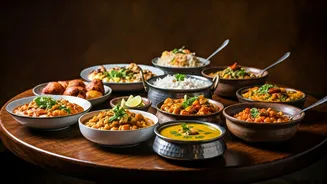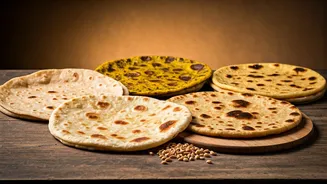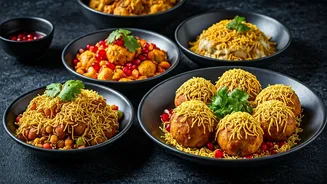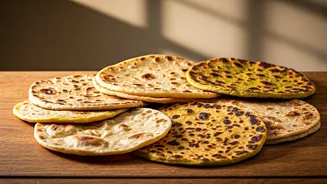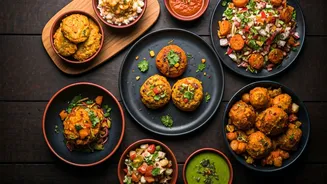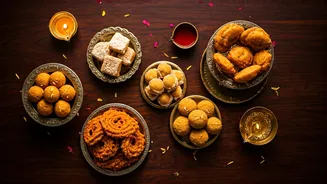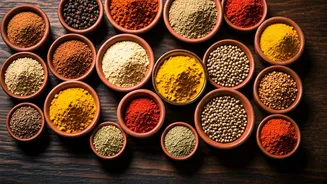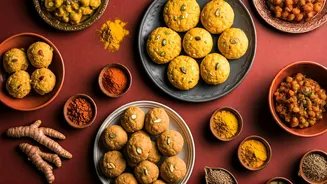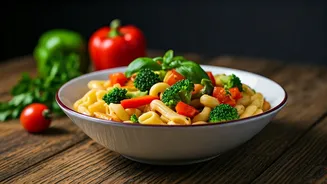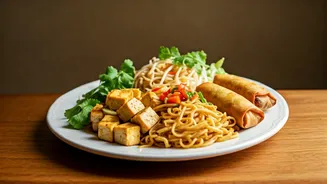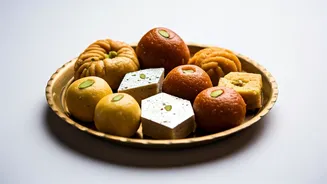Introduction: Indian Dining
Indian cuisine, celebrated for its vibrant spices and diverse flavors, offers a wealth of options for seniors. When planning meals for seniors, it's essential
to consider factors like ease of digestion, nutritional balance, and taste preferences. These recipes focus on wholesome ingredients, gentle cooking methods, and manageable portion sizes to ensure a satisfying and healthy dinner. The goal is to provide flavorful, easy-to-prepare meals that support overall well-being. Each of the ten recipes provides an array of essential nutrients, catering to the dietary needs and preferences of seniors. By selecting recipes rich in vegetables, lean proteins, and whole grains, you can help support their health. These dinners are designed to be easily incorporated into a regular meal plan, promoting a balanced and enjoyable dining experience. The recipes minimize the use of heavy creams and excessive oils, reducing the burden on digestion. The emphasis is on fresh ingredients, aromatic spices, and simple cooking techniques to preserve the original flavors and nutrient content. These meals are not only flavorful but also promote digestive health and ensure a satisfying experience.
Simple Dal Tadka
Dal Tadka, a classic Indian lentil dish, is an excellent choice for seniors because of its high protein and fiber content. It’s also incredibly easy to digest and prepare. Start by rinsing a cup of masoor dal (red lentils) until the water runs clear. Cook the lentils with four cups of water until they become soft. In a separate pan, prepare the tadka (tempering) by heating a teaspoon of ghee or oil. Add cumin seeds, mustard seeds, and a pinch of asafoetida. Once the seeds splutter, add finely chopped onions, tomatoes, and ginger-garlic paste. Sauté until the onions turn golden brown. Pour the tadka over the cooked dal, season with salt and turmeric powder, and simmer for a few minutes. Garnish with fresh coriander leaves before serving. Serve warm with roti or rice. Dal Tadka provides essential protein and fiber, promoting digestive health. It is a light meal perfect for a soothing dinner, easy to adapt to individual taste preferences.
Khichdi: Comfort Food
Khichdi is a one-pot meal that's both nutritious and easy to digest. It combines rice and lentils, cooked with spices, to create a comforting and balanced meal. To make this dish, combine half a cup of rice and half a cup of moong dal (split yellow lentils), washed thoroughly, in a pressure cooker or pot. Add two cups of water and a pinch of turmeric powder, along with a teaspoon of ghee. Pressure cook for three whistles, or simmer until the rice and lentils are soft. Once cooked, you can optionally temper the khichdi with cumin seeds, mustard seeds, and a little asafoetida in ghee. Serve hot with a dollop of ghee and a side of plain yogurt. Khichdi is not only easy to digest but also packed with essential nutrients from the rice and lentils. This easy-to-make dish is gentle on the stomach and provides the energy and nourishment needed for a comfortable evening.
Vegetable Curry: Nutritious Choice
Vegetable curry offers a wonderful way to incorporate a variety of vegetables into the diet, ensuring a good intake of vitamins and minerals. Start by sautéing onions, ginger, and garlic in a pan. Add chopped vegetables like potatoes, carrots, peas, and cauliflower. Sauté for a few minutes before adding a blend of spices such as turmeric, coriander, cumin, and garam masala. Add a small amount of water or vegetable broth and let the vegetables simmer until they are tender. You can also add some diced tomatoes for extra flavor. Season with salt to taste. Serve the vegetable curry with roti or rice. This dish can be customized to include the senior's favorite vegetables. Vegetable curry ensures a good intake of fiber and antioxidants. It can be made mild or spicy, depending on the preference. The diversity of vegetables promotes a balanced intake of nutrients, contributing to overall health and well-being. This dish's flavors make it an enjoyable and nutritious meal.
Roti Sabzi: Classic Combo
Roti sabzi is a fundamental Indian meal that's easy to prepare and highly nutritious. The combination of roti (Indian flatbread) and sabzi (vegetable preparation) is versatile and can be tailored to various dietary needs. Start with preparing the sabzi: you can make a simple potato sabzi (aloo sabzi) by boiling and cubing potatoes and then sautéing them with onions, tomatoes, and spices. Another option is a simple spinach sabzi (palak sabzi) by sautéing chopped spinach with garlic and spices. Prepare the roti by kneading wheat flour with water and a pinch of salt to create a soft dough. Roll out small rounds and cook them on a hot griddle or pan until they puff up slightly. Serve the roti with the chosen sabzi and a dollop of yogurt or a side of raita. Roti sabzi provides a balanced meal with carbohydrates from roti and essential nutrients from sabzi. This combination ensures a filling yet easily digestible dinner, suitable for seniors.
Moong Dal Cheela
Moong dal cheela, a savory pancake made from moong dal, is an excellent source of protein and is easy to digest. Soak one cup of moong dal in water for a few hours or overnight. Drain the water and blend the soaked dal with green chilies, ginger, and a pinch of salt to form a smooth batter. Heat a non-stick pan and grease it lightly. Pour a ladle of the batter onto the pan and spread it into a thin circle. Cook on medium heat until the cheela turns golden brown on both sides. Serve hot with green chutney or tomato ketchup. This dish is rich in protein, which is vital for maintaining muscle mass. Moong dal cheela is also relatively light and gentle on the digestive system, suitable for seniors with sensitive stomachs. This simple yet satisfying meal offers a delightful alternative to traditional dinner options. Its flavor and ease of preparation make it an ideal choice.
Simple Chicken Curry
For non-vegetarian seniors, a simple chicken curry offers a good source of protein and can be prepared in a way that is gentle on digestion. Start by marinating boneless chicken pieces with ginger-garlic paste, turmeric powder, and a little yogurt. Sauté onions, ginger, and garlic in a pan. Add the marinated chicken pieces and sauté until they brown slightly. Add chopped tomatoes and a blend of spices like coriander, cumin, and garam masala. Simmer the chicken in a little water or chicken broth until it's tender. Garnish with fresh coriander leaves. Serve the chicken curry with roti or rice. This curry provides essential proteins and can be adapted to personal taste preferences. The use of boneless chicken and gentle cooking methods make this dish easier to digest. Chicken curry provides necessary protein for maintaining strength, supporting overall health. Its comforting flavor adds enjoyment to the meal.
Vegetable Pulao: One-Pot Meal
Vegetable pulao is a simple and flavorful one-pot rice dish that is an excellent option for seniors. Start by sautéing onions, ginger, and garlic in ghee or oil in a pot. Add chopped vegetables like carrots, peas, and beans. Add rice, washed thoroughly, to the pot along with the vegetables and spices like turmeric and garam masala. Add water and bring it to a boil, then reduce the heat and simmer until the rice is cooked and the water is absorbed. Garnish with coriander leaves and serve hot. This recipe provides a balance of carbohydrates and essential nutrients, being both filling and easy to digest. Vegetable pulao offers a satisfying and flavorful meal, making it an enjoyable experience. The variety of vegetables enhances the nutritional value, ensuring a well-rounded and nutritious dinner. This one-pot preparation simplifies the cooking process.
Idli Sambar: South Indian Classic
Idli and sambar is a classic South Indian combination that is light, nutritious, and easy to eat. Idli, a steamed rice cake, is soft and easily digestible. Sambar, a lentil-based vegetable stew, is packed with nutrients. To make idli, soak urad dal (black gram) and rice overnight. Grind them together into a smooth batter, let it ferment, and then steam the batter in idli molds. For sambar, cook toor dal (split pigeon peas) with vegetables like drumsticks, eggplant, and pumpkin. Add tamarind pulp, sambar powder, and spices. Serve hot with idli and a dollop of ghee. The combination of idli and sambar provides a complete and balanced meal. The fermented idli is easy to digest, and the sambar ensures essential vitamins and minerals. This meal is both flavorful and comforting, providing a delightful and healthy dinner option. This is a flavorful and satisfying meal that is also easy to eat.
Raita: Cooling Complement
Raita, a yogurt-based side dish, serves as a cooling complement to the other dishes, adding both flavor and nutritional value. You can make a simple cucumber raita by whisking yogurt and adding grated cucumber, a pinch of salt, and a sprinkle of roasted cumin powder. Another option is a boondi raita, made with soaked and added to yogurt, along with spices. Raita is easy to digest and helps balance the richness of other dishes. It provides probiotics, beneficial for gut health. This refreshing side dish adds an element of freshness, enhancing the overall dining experience. Raita's cooling effect can also make meals more comfortable, especially in warmer climates. The added spices and vegetables also provide additional flavors and nutrients. Raita is a versatile dish that enhances the experience.
